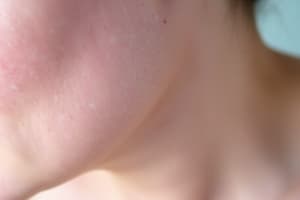Podcast
Questions and Answers
What is the duration of exposing the lesion to the low-power laser?
What is the duration of exposing the lesion to the low-power laser?
- 15-30 minutes (correct)
- 30-60 minutes
- 1-5 minutes
- 1-2 hours
What is the recommended frequency of exercise therapy for improving the immune system?
What is the recommended frequency of exercise therapy for improving the immune system?
- 3-5 times per week (correct)
- 2-3 times per week
- Every day
- 5-7 times per week
What is the purpose of skin rolling and wound relaxation treatment after skin grafting?
What is the purpose of skin rolling and wound relaxation treatment after skin grafting?
- To relieve pain and improve skin movement (correct)
- To prevent infection
- To reduce stress and anxiety
- To promote skin pigmentation
Why is maintaining a comfortable body posture important for people with vitiligo?
Why is maintaining a comfortable body posture important for people with vitiligo?
What is the recommended intensity of exercise therapy for vitiligo patients?
What is the recommended intensity of exercise therapy for vitiligo patients?
What type of laser is used in the treatment of vitiligo?
What type of laser is used in the treatment of vitiligo?
Why is vitiligo more noticeable in people with darker skin color?
Why is vitiligo more noticeable in people with darker skin color?
What is the purpose of depigmentation therapy in vitiligo treatment?
What is the purpose of depigmentation therapy in vitiligo treatment?
What is the duration of depigmentation therapy?
What is the duration of depigmentation therapy?
What is thought to be the primary cause of vitiligo?
What is thought to be the primary cause of vitiligo?
What are the common areas where vitiligo patches appear?
What are the common areas where vitiligo patches appear?
What happens to the hair in areas affected by vitiligo?
What happens to the hair in areas affected by vitiligo?
What is the effect of depigmentation on the skin?
What is the effect of depigmentation on the skin?
What is the chemical used in depigmentation therapy?
What is the chemical used in depigmentation therapy?
What is the pattern of depigmentation in which it develops on only one side of the body?
What is the pattern of depigmentation in which it develops on only one side of the body?
What is the percentage chance of returning color on the face, trunk, and upper arms and upper legs with PUVA treatment?
What is the percentage chance of returning color on the face, trunk, and upper arms and upper legs with PUVA treatment?
What is the possible long-term side effect of PUVA treatment?
What is the possible long-term side effect of PUVA treatment?
Why must UVA blocking eyeglasses be worn during PUVA treatment?
Why must UVA blocking eyeglasses be worn during PUVA treatment?
What is the age limit for using PUVA treatment in children?
What is the age limit for using PUVA treatment in children?
What is the frequency of Narrow Band UVB (NBUVB) treatment?
What is the frequency of Narrow Band UVB (NBUVB) treatment?
What is the purpose of psoralen in PUVA treatment?
What is the purpose of psoralen in PUVA treatment?
What is the duration of PUVA treatment required to achieve significant results?
What is the duration of PUVA treatment required to achieve significant results?
Flashcards are hidden until you start studying
Study Notes
Vitiligo
- Vitiligo is more noticeable in people with darker skin color.
Depigmentation Therapy
- Removes remaining pigment from normal skin to make the whole body an even white color.
- Uses a chemical called monobenzylether of hydroquinone.
- Takes about a year to complete.
- Results in permanent pigment removal.
Causes of Vitiligo
- Unknown, but several theories exist.
- Strong evidence suggests that people with vitiligo inherit a group of three genes that make them susceptible to depigmentation.
- Most widely accepted view is that vitiligo is an autoimmune disease, where the immune system reacts against the body's own organs or tissues.
- Another theory is that melanocytes destroy themselves.
Vitiligo Symptoms
- Characterized by the appearance of depigmented patches (milky white) on the skin.
- Common in sun-exposed areas like hands, feet, arms, face, and lips.
- Also affects armpits, groin, around the mouth, eyes, nostrils, navel, and genitals.
- Rarely, patches show slight erythema, but mostly only depigmentation and sensitivity to light.
- Hair may turn white in affected areas.
Patterns of Vitiligo
- Focal Pattern: Depigmentation is limited to one or a few areas.
- Segmental Pattern: Depigmentation develops on one side of the body.
- Generalized Pattern: Depigmentation develops on different parts of the body.
Physical Therapy for Vitiligo
PUVA
- A form of repigmentation therapy using psoralen medication.
- Makes skin sensitive to light, then treats with UVA light.
- Chance of returning color is 50-70% on face, trunk, and upper limbs, but poor response on hands and feet.
- Requires at least a year of twice weekly treatments.
- Side effects include sunburn-type reactions, freckling, and increased risk of skin cancer.
- Not usually used in children under 12, pregnant or breastfeeding women, or individuals with certain medical conditions.
Narrow Band UVB (NBUVB)
- A form of photo-therapy requiring skin treatment two to three times a week for a few months.
- Not widely available, but may be useful in treating children with vitiligo.
Laser Therapy
- Uses low-power laser for 15-30 minutes.
- Can be used on a small portion of vitiligo, often with topical medications.
- Complications include redness and blistering.
Lifestyle Changes
- Maintaining a comfortable body posture and mind is important, as vitiligo worsens with physical and mental stress.
- Exercise therapy, such as swimming and aerobic exercise, can improve the immune system.
- Manual therapy, including grafting, can be useful for a small group of vitiligo patients.
Studying That Suits You
Use AI to generate personalized quizzes and flashcards to suit your learning preferences.




